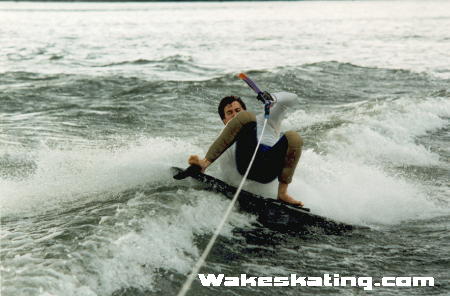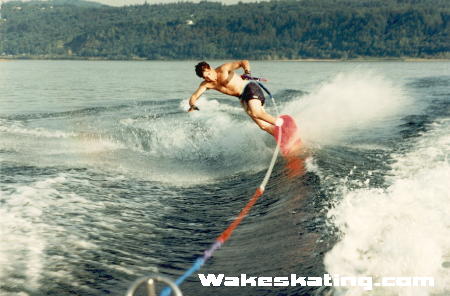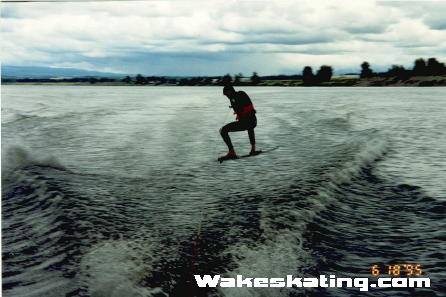
 Home Home
 All Articles All Articles
 Wakeskate Guide Wakeskate Guide
 Discussion Forums Discussion Forums
 Features Features
 Reviews Reviews
 Trick Tips Trick Tips
 Wakeskating History Wakeskating History
 Links Links
 Link To Us Link To Us
 Wakeboarding Wakeboarding
 Wakesurfing Wakesurfing
 Wakeboards Wakeboards
 Wakeboard Towers Wakeboard Towers
 Hyperlite Wakeskates Hyperlite Wakeskates
 Liquid Force Wakeskates Liquid Force Wakeskates
 Byerly Wakeskates Byerly Wakeskates
 Buy Wakeboards Buy Wakeboards
 Ronix Wakeboards Ronix Wakeboards
 Liquid Force Wakeboards Liquid Force Wakeboards
 Buy Wakeskates Buy Wakeskates
 Wakeboard Towers Wakeboard Towers
 Wakepics Wakepics
 Wake Videos Wake Videos
 Complete Longboards Complete Longboards
 Article Alert Article Alert

 Media Center Media Center
 Pictures Pictures
 Videos Videos
 Buy Wakeskate Videos Buy Wakeskate Videos

 Grip Deck Grip Deck
 Getting Up Getting Up
 Dock Start Dock Start
 Ollie Ollie
 HS Wake Jump HS Wake Jump
 TS Wake Jump TS Wake Jump
 HS Backside 180 HS Backside 180
 BS Pop Shuvit BS Pop Shuvit
 FS Pop Shuvit FS Pop Shuvit
 Surface 180 Shuvit Surface 180 Shuvit
 FS Bigspin FS Bigspin
 TS Shuvit to Indy TS Shuvit to Indy
 Kickflip Kickflip

 Advertise Advertise
 Contribute Articles Contribute Articles
 Submit A Trick Submit A Trick
 Feedback Form Feedback Form
 Visitor Feedback Visitor Feedback
 About RSS About RSS
|
Wakeskating's Beginnings: The Jason Messer Interview Author: Wakeskating.com Staff Author: Wakeskating.com Staff
11-15-2005
The style and ideals that help comprise the personality that is Jason Messer make him a rare breed. He is a creative, selfless, and thoughtful individual who had the rare opportunity to pioneer an art form without any reference points at its earliest, and arguably most crucial stages. There was nobody in his environment that rode the way he rode or thought the way he thought. An industry with groundbreaking products to help the advancement of one's riding did not exist, and there were no politics to conflict with the idea of personal expression and one's riding translating a certain personal "feeling" vs. legitimacy and a responsibility to represent one's art properly. Moreover, an understanding barely existed that might help outsiders comprehend what it really meant to ride bindingless, which made the journey that much more difficult. Yet, somehow he knew just how to ride and just what to create, in order to make everyone understand what he always knew.
More importantly, he saw potential in an activity that gave him a great amount of personal satisfaction. He invested his time and energy into it, with the idea that there had to be other people that just might feel the same way he did. For him, this made all the work all the more worth it.
Influenced by experiencing the early Southern California lifestyle and environment that included a heavy skate and surf culture of the 70's, Jason would make his own path and develop a riding style that suited his personality through the use of a board and traction, which would eventually evolve into what we now call a "wakeskate."
Jason would go on to become a master of his art by means of an open mind, progressive riding and progressive thinking. To aid in his riding, he developed the first products that catered specifically to wakeskating, under the company name "Fresh Water Traction", with the idea of making something that would not only allow a rider to perform better, but to also allow people to experiment with different boards in an era when "defacing" a wakeboard was the last thing most riders at that time wanted to do.
Finally, but certainly no less important, is the way Jason promoted wakeskating. This personal innovation he had dedicated his time and resources to meant a lot to him. But when the time came to let wakeskating go with the idea of growth in mind, it was done so selflessly and in the best interest of the future of wakeskating.
With that said, this is Jason's story. It is simply his journey through wakeskating, the things he experienced, and the people that affected him, in his own words.
WS: When and where did you start wakeskating?
Jason Messer: When and where....well, I’ll give you a couple starting points. In the mid 80's in high school we used to ride at this place called Frenchman’s bar. And my friends and I used to give this guy, this farmer, a dollar and put it on his porch in a box and he’d let us go onto his shoreline because he lived right along the Columbia river, and he owned about a mile to two miles of just really nice sandy shoreline. And it was like 1985, I had this Connelly Winger, it was an old kneeboard and basically, my friends would have baja bugs and jeeps, and I would put a rope on the roll bar and attach it to a handle and basically, I would skim behind them while they were driving on the sandy beach. You see? And it was a really cool place because it was a pretty industrial area and they had these huge tires and they were sunken in the sand.
And it was tidal so when the tide was right--we’d wait for the tide to be right when the tire was sticking out probably three or four inches--I’d ride over that and I would learn to ollie by first hitting the back of the board against the tire and that was just kind of wallieing me up over the tire and like, landing over the tire, if that makes sense. That was my first experience with ollieing a board. And I’d use that knee strap in the front; I’d just kind of put my front foot into that a little bit so I could kind of use it for a little bit of leverage. And so that was a long time ago.
But that was what planted the seed. It was really like skimming--we were just skimming over three inches of water. And there were all these sandy transitions that I could ride up on and ride back down on. And there was even this old shipwrecked--it was just this little boat that was washed up on shore--and that was when I did my first bomb drop, too. You know, just kind of acid drop off the bow of the boat.
And at that point I was like, yeah--this was before skurfing as I knew it, and skurfers weren’t out or anything. So it was kind of the only thing that we had, really, to ride behind or stand up on behind, because I wasn’t really interested in riding on my knees and stuff, so...
WS: I can’t even believe you were able to ollie a kneeboard [laughs].
J: [Laughs] You know, we waited for the tire to get like seven inches or so out of the water. And then you push your back end off into the water right at the same time that you’re hitting that tire. Yeah, absolutely, it was just like an old school wallie, like how we used to do wallies off of walls on skateboards. So it was kind of that same way of doing it and stuff. So that was way cool. I remember just being able to go along the shoreline on basically wet sand, just carve and then coming back down. That was when I started doing 360's and stuff, and it was just so easy.
And that board, that was actually a pretty good board. I like custom--the kneepads-- I customized them so they were more like footpads and stuff so...I don’t know [laughs]. But that was probably my first experience of just like, riding without bindings, you know? Like, skim style. Fast-forward and I can tell you about the modern day–how it started when wakeboards finally came in the picture [laughs].
WS: Yeah, you can do that! That old story was pretty cool. I’ve never really heard anything like that before. Thomas, for instance, started out with like cut down wakeboards. I’ve never really heard of anybody doing what you did, and it sounds cool, too.
J: Well, in 1993 they came out with this board called the Slam Channel, the Surf Alley Slam Channel.

The Surf Alley wakeboard from 1993.
WS: Oh, yeah, yeah.
J: Okay [Laughs]. It was an old Kidder board. It was like the first real board too...it was just a really good board. It was one of Chris Durham’s first boards and he went on to head Wake Tech as a company. But anyways, I bought one of those boards, a Slam Channel. And it has a channel down the center of the board so you could adjust your bindings down a channel lock-it was called a Channel Lock or something. It wasn’t just like bolts into the board.
So what I did was, right when I got the board I was thinking to myself, “I want to ride this without bindings. I want to skateboard behind my boat.” And so what I did was I bolted an old, well not old, it was probably pretty new because it was like 1993 or something. It was a Tommy Guerrero skateboard, and I bolted that onto the top of my Surf Alley–on the top of my wakeboard–and then just screwed it in with that Channel Lock. And I just bolted that thing onto my board and I was just like, let’s go.
So my dad was driving and we went out because we had our boat on the Columbia river. And my dad was just kind of laughing at me 'cause it was kind of funny I guess, looking at a skateboard on the top of a wakeboard or whatever [laughs]. And I think that I even put surf wax on the top of my grip tape or something...
WS: [Laughs].
J: But anyways, so I just got in the water and kind of started to feel it out and everything, and I was just like, “Hit it.” And the next thing I know, I’m riding. And I was basically riding my skateboard on top of my wakeboard. And that was really kind of the start, that was just a “let’s do it” kind of thing [laughs].
I just kind of thought about it and I just went into the garage and built it, and then within a half hour I’ve got a skateboard on top of a wakeboard. And we went right down to the river, and the next thing I know I’m on top of that thing. And as soon as I got on top of the board or on top of the water, and started planing and started carving and stuff, I looked at my dad and he’s kind of laughing at me or whatever.
But my head just started really thinking at that point, like I just couldn’t stop at that moment. As soon as I felt the feeling, and as soon as I started carving, and as soon as I put my back foot on the tail of my skateboard and started to kind of feel what I could really do, it really kind of brought back memories of what we used to call “winging” in the 80's. It kind of brought to the future for me because a lot had happened in those six years with like aerial surfing and my skateboarding skill and everything. So it really, my mind just wouldn’t stop. From that day forward that was just like, it was just wakeskating for me, from that day forward [laughs]. So...
WS: That’s awesome! That’s another one I’ve never heard of; I’ve never heard of anyone bolting a skateboard onto a wakeboard like that.
J: Uh huh. Well, nobody--all boards nowadays just have holes, you know, where you have to put your bindings where ever. For some reason, that Slam Channel had just a center groove where you could just put your bindings anywhere you wanted on that board. So it made it really easy for me to bolt my skateboard on and using the truck pattern on my skateboard and just like, there you go. So it was really easy to do.
WS: Do you remember your initial reaction when you first started wakeskating and actually made it work?
J: Well, yeah, I guess it would be that day [laughs]. But, you know, it was using these boards, using wakeboards and finding a board that rode good on the water, you know?
It was just hard cause everything was directional. You know, surfboard style. And, so yeah, it was like, just to have a board that rode good and then just to not have bindings on your board, and just feel where that could go. It was really like...it just felt really right, and it felt like this was exactly what I needed to be doing. And I need to show as many people as I can and get something out so people can just put them onto their boards. That was my thinking right off the bat like, “Oh, okay. This is really cool and a lot of people are going to like this, I just know it.”
And I just thought, “Well, how can I help give people the things to make a wakeskate to ride without bindings?” So that was like my whole development from that point on; I just need to make boards, make traction pads, do whatever I can to just–because the feeling of riding without bindings was so good and felt so right that I just knew that everybody needed to check it out [laughs].

Layback? WAYBACK! That's a double meaning, kids, and it dates back to c. 1995.
WS: So, and this almost seems obvious, too, but was there any style you wanted to emulate on the water? You’re from Oregon, aren’t you?
J: Yeah, well, I was raised in Southern California in Orange County. And we moved up here, to Oregon, when I was like 10. So I had kind of been raised in the skateboard culture of the late 70's of California, and then we moved up here and surfing was something that just kind of missed me, you know? Because I wasn’t really old enough to surf in California, but I always liked to watch surfing, and I always really liked the thought of surfing.
But I was always like, I’d like to surf behind a boat, and I’d like to skate behind a boat. I’d like to do what these surfers in Laguna were doing. I wanted to do aerial surfing. It was kind of like skateboarding on the water, even though it wasn’t known at the time. Aerial surfing was really cool so I was really attracted to that style of riding–aerial surfing.
And I really liked hybrid surfboards and all the new stuff that was being developed at that time, especially the flow parks and the flow boards. And I just really felt like riding behind the boat could be just like aerial surfing on the wave, and just how high could you boost off that lip, and how much and stuff like that. And that was really, kind of, my version of riding. It was a little bit–even though skateboarding is in-my-blood, that’s my background. But still, like putting a surfing spin on that, too.
You know skateboarding...that’s kind of where I was seeing it at the time. And especially thinking about boards and making high performance boards; boards that really worked well. You know, like foam composite boards with heavy-duty fiberglass with some nice flex sections in the board that would just racket the board off the wake and stuff like that. Kind of like with surfers, they love their boards; hand made boards and all of this stuff makes them ride so much more explosive. So I was really into that whole thing. You know, like high performance waterboards.
 Backside re-entry ollie on a homemade wakeskate, c. 1994.
Backside re-entry ollie on a homemade wakeskate, c. 1994.
WS: Yeah, that’s cool. And like nowadays, skateboarding has a huge influence on wakeskating. But there are a lot of people that have actually brought it to my attention that–since I don’t surf–that wakeskating has a lot to do with surfing, too. It’s about flowing on the water and using those transitions.
J: Yeah, exactly. There’s a lot of energy in the water; there’s a lot of potentials in the water and it really is about you riding on something...it’s just like riding on the water and really feeling the water. You know, just feeling that energy inside the water because there’s so much that you can generate from that water, especially at speeds.

Backside air, wake to wake, you know the date.
...
To proceed to section two, click here.
Shop For Wakeskating Gear 
 Hyperlite Girls Child Indy Vest Purple Hyperlite Girls Child Indy Vest Purple

|
|

 Wakeboards Wakeboards
 Ronix Wakeboards Ronix Wakeboards
 Hyperlite Wakeboards Hyperlite Wakeboards
 Liquid Force Wakeboards Liquid Force Wakeboards
 Slingshot Wakeboards Slingshot Wakeboards
 CWB Wakeboards CWB Wakeboards
 Wakeboard Bindings Wakeboard Bindings
 Ronix Bindings Ronix Bindings
 Hyperlite Bindings Hyperlite Bindings
 Liquid Force Bindings Liquid Force Bindings
 Slingshot Bindings Slingshot Bindings
 CWB Bindings CWB Bindings
 Wakeboard Packages Wakeboard Packages
 Wakeskates Wakeskates
 Wakesurf Boards Wakesurf Boards
|